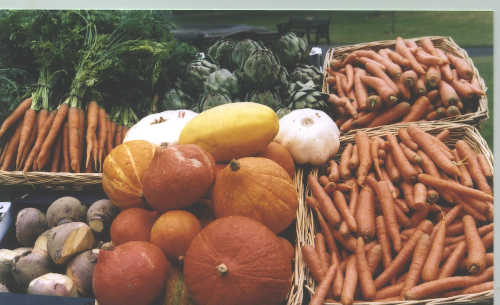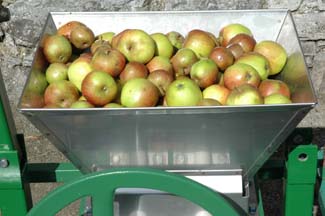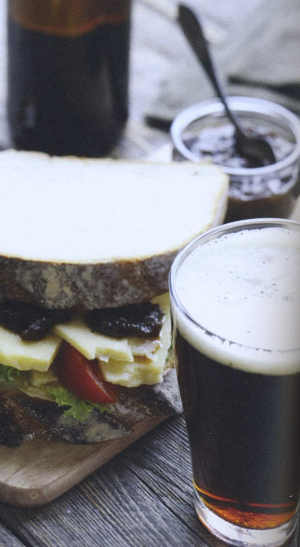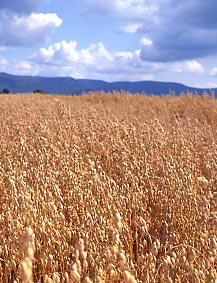This year will see the resurgence of some old acquaintances - the Tasting Menu is very much in the ascendant again, for example, albeit with a change of emphasis, including more casual service style. And, while demand for sustainable, wild and ‘real’ foods is a grounding force, unexpected things you may notice creeping onto your menu - or find in your favourite food store - include insects (anyone for crickets? seriously…), unusual grains, and seafood charcuterie. And techie types will welcome the arrival of ‘digital dining’ (ie doing everything on your mobile, including paying the bill).
 1. For so long the culinary Cinderella, vegetables are coming out to take the starring role on many a fancy menu where - following the lead of the fashionable Nordic cuisine, with its emphasis on foraged foods - traditional meats and fish now play second fiddle. Belfast’s Ox restaurant is an exciting Irish example of the trend. Almost forgotten vegetables like salsify are becoming familiar to diners once again, but many everyday workhorses are also finding favour in unexpected ways - notably cauliflower, which has been ‘discovered’ by chefs who seem astonished by its versatility and have a special fondness for using it in the (also increasingly popular) purées that appear as artistic smears across the plate. While many vegetables make their mark in restaurants as miniatures, shavings or other tiny accompaniments, others provide ingenious alternatives to staples such as pasta and even meat - whose star seems to be in the descendant, with ‘less but better’ the new mantra for health-conscious carnivores. Whatever the motivation for their use, fresh vegetables are full of vitamins, anti-oxidants, fibre and the many other good things that make them ideal for the juicing craze (see below). Here’s hoping for plenty of hearty vegetable dishes to enjoy as well, whether eating out or cooking at home - and fair prices for their producers, please.
1. For so long the culinary Cinderella, vegetables are coming out to take the starring role on many a fancy menu where - following the lead of the fashionable Nordic cuisine, with its emphasis on foraged foods - traditional meats and fish now play second fiddle. Belfast’s Ox restaurant is an exciting Irish example of the trend. Almost forgotten vegetables like salsify are becoming familiar to diners once again, but many everyday workhorses are also finding favour in unexpected ways - notably cauliflower, which has been ‘discovered’ by chefs who seem astonished by its versatility and have a special fondness for using it in the (also increasingly popular) purées that appear as artistic smears across the plate. While many vegetables make their mark in restaurants as miniatures, shavings or other tiny accompaniments, others provide ingenious alternatives to staples such as pasta and even meat - whose star seems to be in the descendant, with ‘less but better’ the new mantra for health-conscious carnivores. Whatever the motivation for their use, fresh vegetables are full of vitamins, anti-oxidants, fibre and the many other good things that make them ideal for the juicing craze (see below). Here’s hoping for plenty of hearty vegetable dishes to enjoy as well, whether eating out or cooking at home - and fair prices for their producers, please.
2. But the best bit for most people, affecting our attitude to everyday meals, is that ‘real food’ is back in favour - and the trend is growing. The connection between processed foods and obesity, among other health problems, is at last becoming a matter of urgent public debate and, significantly, animal and poultry fats are no longer held up as the ‘bad’ foods they’ve been for decades. So those who previously avoided them on health grounds are now ‘allowed’ to enjoy butter and cream again with a clear conscience - balanced by plenty of other fresh foods, of course, including the healthy snacks that are now making inroads on that massive market. The role of ‘free from’ foods is growing too, with food intolerances - especially to gluten - taking centre stage; gluten free products will continue to improve, including the range offered in restaurants. Better still, the strong health case being made for eating fresh foods brings weight reduction ‘diet foods’ into the firing line - and about time too.
 3. The new love affair with vegetables, along with ‘real food’ and foraged foods, brings another culinary character into play: juice. Astonishing (but not incredible) health claims surround this phenomenon, especially where dark-leaved green vegetables are concerned, but the most creative manifestation is on restaurant menus - most famously chef René Redzepi’s restaurant Noma, in Copenhagen, where specially created juice pairings are offered for the tasting menu and many would say that they outshine wine as a match for such exceptional food. This trend is only in its infancy but all the signs are that it will be huge - and, hopefully, it will also inspire the development of a whole range of interesting and natural non-alcoholic drinks.
3. The new love affair with vegetables, along with ‘real food’ and foraged foods, brings another culinary character into play: juice. Astonishing (but not incredible) health claims surround this phenomenon, especially where dark-leaved green vegetables are concerned, but the most creative manifestation is on restaurant menus - most famously chef René Redzepi’s restaurant Noma, in Copenhagen, where specially created juice pairings are offered for the tasting menu and many would say that they outshine wine as a match for such exceptional food. This trend is only in its infancy but all the signs are that it will be huge - and, hopefully, it will also inspire the development of a whole range of interesting and natural non-alcoholic drinks.
 4. While juices may be seen in some quarters as the new wine, there is no stopping the growth of craft beers, cider and spirits - in the spirits world think names like Teelings Whiskey, Dingle Distillery and the new boutique distillers such as Shortcross Gin and Highbank Organic Orchard Spirit - and, of course, cocktails, among a whole range of innovative drinks. Vermouth, so long consigned to dusty top shelves, is having a revival - and, probably as a result of what’s going on with aromatic bitters in mixology, the flavour of the year is set to be ‘bitter’. It’s an unlikely food hero perhaps, but one that can offset blandness and counteract sweetness through the careful use of common foods like citrus fruits (using traditional varieties of lemon, lime and grapefruit that have not been bred for sweetness), ‘bitter salads’ like chicory, endive and dandelion leaves, and some less obvious sources such as pomegranate seeds. It promises to be an interesting year for adventurous tastebuds.
4. While juices may be seen in some quarters as the new wine, there is no stopping the growth of craft beers, cider and spirits - in the spirits world think names like Teelings Whiskey, Dingle Distillery and the new boutique distillers such as Shortcross Gin and Highbank Organic Orchard Spirit - and, of course, cocktails, among a whole range of innovative drinks. Vermouth, so long consigned to dusty top shelves, is having a revival - and, probably as a result of what’s going on with aromatic bitters in mixology, the flavour of the year is set to be ‘bitter’. It’s an unlikely food hero perhaps, but one that can offset blandness and counteract sweetness through the careful use of common foods like citrus fruits (using traditional varieties of lemon, lime and grapefruit that have not been bred for sweetness), ‘bitter salads’ like chicory, endive and dandelion leaves, and some less obvious sources such as pomegranate seeds. It promises to be an interesting year for adventurous tastebuds.
5. Thinking producers, shoppers and diners have long recognised the importance of sustainability and it’s now becoming a mainstream movement as growing numbers of consumers seek out and support thoughtfully produced, locally sourced foods. This ties in with the trend towards ‘real food’ and (however belatedly) renewed recognition of the value of vegetables. Animal welfare and environmental concerns are increasingly seen as a consumer issue, with people power capable of forcing production practices to change for the better, and - although there is surprisingly little mention of the growing demand for organically produced foods in the many food forecasts that have been doing the rounds recently - this trend will continue to develop. However, plummeting prices - including below cost selling by unscrupulous retailers - threaten the viability of sustainable production and urgent action is needed to ensure fair prices for producers.
 6. It’s hard to put forward arguments to counter those made by meat eaters who feel the need to scale down consumption (does anyone ever really need a 32oz steak?), and, unsurprisingly, this is set to become a movement - the UK’s inaugural Meat Free Week, for example, is planned for late March this year and aims to raise awareness of issues such as factory farming. But, on the other hand, the foraged ingredients that are so popular in Nordic cuisine and play a part in the sustainable food movement include other meats which are on the ascendant, notably wild game and fish; variations of the Italian cured salted fish roe, bottarga, is an example which is much sought after internationally by chefs whose uses for it include flavouring a wide range of other foods. Along with other delicacies such as smoked eel (one up for the Lough Neagh Eels, PGI), fish roe and other cured, pickled and fermented foods take their place on ‘seafood charcuterie’ platters or salumi di mare that can partner - or replace - the traditional meat platters that make such great sharing dishes.
6. It’s hard to put forward arguments to counter those made by meat eaters who feel the need to scale down consumption (does anyone ever really need a 32oz steak?), and, unsurprisingly, this is set to become a movement - the UK’s inaugural Meat Free Week, for example, is planned for late March this year and aims to raise awareness of issues such as factory farming. But, on the other hand, the foraged ingredients that are so popular in Nordic cuisine and play a part in the sustainable food movement include other meats which are on the ascendant, notably wild game and fish; variations of the Italian cured salted fish roe, bottarga, is an example which is much sought after internationally by chefs whose uses for it include flavouring a wide range of other foods. Along with other delicacies such as smoked eel (one up for the Lough Neagh Eels, PGI), fish roe and other cured, pickled and fermented foods take their place on ‘seafood charcuterie’ platters or salumi di mare that can partner - or replace - the traditional meat platters that make such great sharing dishes.
 7. Staying with the sea, after a lapse of several generations the value of edible seaweeds is being recognised once again and - having mainly appealed to an adventurous minority in recent years - they are set to go mainstream. Ireland is probably ahead of the curve in this area, with some seaweeds such as carrageen and dillisk still widely used and many people keen to renew connections with foods and skills that were part of everyday life for their grandparents and earlier generations, especially in the west of Ireland. Another side to their appeal is the exceptional health and nutritional benefits of seaweeds, which have been gently introduced to foragers and consumers by experts like Dr Prannie Rhatigan, whose book The Irish Seaweed Kitchen has given a new generation the confidence to explore these once familiar ‘new’ ingredients. Locally foraged seaweeds and specialist seaweed (or ‘sea vegetable’) companies are seeing sales soar and this is set to continue, especially as many user friendly new products, including seaweed seasonings, are making it much easier for both chefs and home cooks to experiment with them.
7. Staying with the sea, after a lapse of several generations the value of edible seaweeds is being recognised once again and - having mainly appealed to an adventurous minority in recent years - they are set to go mainstream. Ireland is probably ahead of the curve in this area, with some seaweeds such as carrageen and dillisk still widely used and many people keen to renew connections with foods and skills that were part of everyday life for their grandparents and earlier generations, especially in the west of Ireland. Another side to their appeal is the exceptional health and nutritional benefits of seaweeds, which have been gently introduced to foragers and consumers by experts like Dr Prannie Rhatigan, whose book The Irish Seaweed Kitchen has given a new generation the confidence to explore these once familiar ‘new’ ingredients. Locally foraged seaweeds and specialist seaweed (or ‘sea vegetable’) companies are seeing sales soar and this is set to continue, especially as many user friendly new products, including seaweed seasonings, are making it much easier for both chefs and home cooks to experiment with them.
 8. Grains are massively important on a global scale and the search is on to find one with almost miraculous qualities (abundant, healthy as in ‘superfood’, versatile, tasty…). Grains that have come into favour of late include millet (as commonly used in bird food seed mixes), which is gluten-free and suits delicate digestive systems, and just recently an old Middle Eastern grain, freekeh, which is on a winner with its nutty flavour and high protein content. Having been adopted by a number of top chefs (including Skye Gyngell at her stunning new restaurant, Spring, at London’s Somerset House), it’s now set to go mainstream and you may even find it in the range of pre-cooked grain mixes at your local M&S, where grains are set to be big news this year. And personally I’d like to see barley on every Irish shopping list - it’s grown locally, inexpensive, natural, nutritious and enormously versatile; barley has great flavour and texture and can be used to replace other carbohydrates such as rice in a wide range of dishes (try it in a lovely chewy pilaf, for example). A handful makes a great addition to hearty soups and casseroles and, while it’s not gluten-free, it helps lower cholesterol among many other health benefits. So let’s hear it for barley this year.
8. Grains are massively important on a global scale and the search is on to find one with almost miraculous qualities (abundant, healthy as in ‘superfood’, versatile, tasty…). Grains that have come into favour of late include millet (as commonly used in bird food seed mixes), which is gluten-free and suits delicate digestive systems, and just recently an old Middle Eastern grain, freekeh, which is on a winner with its nutty flavour and high protein content. Having been adopted by a number of top chefs (including Skye Gyngell at her stunning new restaurant, Spring, at London’s Somerset House), it’s now set to go mainstream and you may even find it in the range of pre-cooked grain mixes at your local M&S, where grains are set to be big news this year. And personally I’d like to see barley on every Irish shopping list - it’s grown locally, inexpensive, natural, nutritious and enormously versatile; barley has great flavour and texture and can be used to replace other carbohydrates such as rice in a wide range of dishes (try it in a lovely chewy pilaf, for example). A handful makes a great addition to hearty soups and casseroles and, while it’s not gluten-free, it helps lower cholesterol among many other health benefits. So let’s hear it for barley this year.
9. Sugar has become the latest big no-no food, but we should remember previous food vendettas - eggs, dairy products - that have since been contradicted, and not lose sight of its usefulness. The dangers of its misuse are easy to see of course and, as pointed out by Darina Allen, ordinary sugar seems mysteriously to have become 20% sweeter in recent years, something she suspects may be connected to the fact that we are no longer producing our own sugar from Irish sugar beet. Consequently the Ballymaloe Cookery School team has been working through their recipes since last year and reducing the sugar content accordingly. However, used responsibly within a balanced diet where the much greater dangers of processed foods are understood, sugar remains an essential in every kitchen. A natural preservative, it allows us to enjoy some of the most delicious seasonal food all year - how else would we make that wonderful raspberry jam (everybody’s favourite it seems) or, for that matter the meringues that break up so seductively in whipped cream and luscious berries to make a classic Eton Mess. Enough said - we will continue to enjoy sugar in 2015, and beyond.
10. The relentless search for alternative sources of protein to replace or complement meat and dairy foods continues, and with some unlikely successes. So, for example, oddities you may come across in 2015 include insects, such as crickets and scorpions, which have been important food sources in many parts of the world for millennia. Although some creative PR may be needed to widen their appeal in Europe, they have been creeping onto some adventurous menus in France and are already being farmed in America. On a more homely note, we shouldn’t forget the great alternative protein sources that are on our own doorstep - and, for many of us, already growing in our back gardens. Pulses are king of course, when it comes to vegetable proteins, and the one that is currently causing great excitement is none other than the cheery little pea. A strong case is also being made for frozen foods at the moment and you won’t find a better example than peas, which are processed so quickly that they’re fresher from the freezer than bought in pod at your local greengrocer. But that’s too simple by far for the alternative protein hunters, so you may expect to see pea protein listed as an ingredient (often as a healthier, GM-free replacement for soy protein) in a whole host of unlikely foods. And that’s not all, pea starch and pea hull fibre have their uses too. Anyone for pea pasta?
There are currently no comments
Leave a comment
Not a member? Register for your free membership now!
Or leave a comment by logging in with: